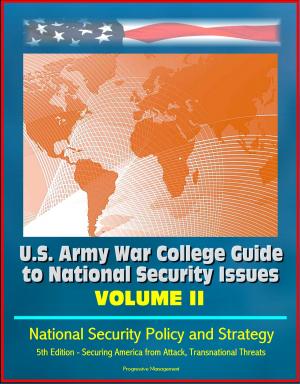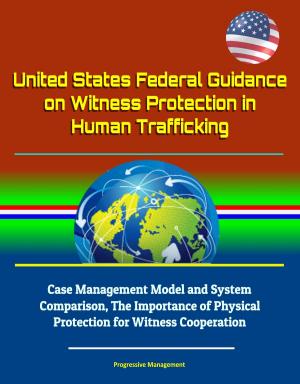Gangs and Crime in America: Central America and Mexico Gang Assessment, Cost of Violence, Profiles of El Salvador, Guatemala, Honduras, Mexico, and Nicaragua, Risk Factors, Historical Context
Nonfiction, History, Americas, Central America, Social & Cultural Studies, True Crime| Author: | Progressive Management | ISBN: | 9781370771721 |
| Publisher: | Progressive Management | Publication: | April 21, 2017 |
| Imprint: | Smashwords Edition | Language: | English |
| Author: | Progressive Management |
| ISBN: | 9781370771721 |
| Publisher: | Progressive Management |
| Publication: | April 21, 2017 |
| Imprint: | Smashwords Edition |
| Language: | English |
This excellent report has been professionally converted for accurate flowing-text e-book format reproduction.
Recognizing that gang activity is a complex, multi-faceted, and transnational phenomenon that is clearly in the national interest to address, the USAID Bureau for Latin America and the Caribbean Office of Regional Sustainable Development (LAC/RSD) initiated the Central America and Mexico Gang Assessment to study the phenomenon and propose solutions in five countries - El Salvador, Guatemala, Honduras, Mexico, and Nicaragua. The objectives of the Central America and Mexico Gang Assessment are to: (1) analyze the nature of gangs, their root causes, and other factors driving the phenomenon; (2) examine the transnational and regional aspects of gangs in Central America and Mexico, including the impact of deportation and immigration trends; (3) evaluate policies and programs and identify best practices in the assessment countries and the United States; and (4) provide strategic and programmatic recommendations to USAID about addressing the gang problem in the assessment countries.
Gang members and gang networks are heterogeneous. Gang members in Central America and Mexico are not homogenous. There is no typology applicable to every gang or gang member, and not all gangs have the same objectives or engage in the same type of activities or with the same level of violence. Although each country has its own brand of gang problem, the factors driving gang activity throughout the region include a lack of educational and economic opportunities, marginalized urban areas, intra-familial violence and family disintegration, easy access to drugs and firearms, overwhelmed and ineffective justice systems, and the "revolving door" along the U.S.-Mexico border.
U.S. Congressional Interest in Gang Issues * USAID Involvement in Addressing Gangs * Assessment Objectives * The Typology of Gangs in Central America and Mexico * Responses to Gang Activity: The Prevention—Intervention—Law Enforcement Continuum * The Gang Phenomenon in Central America and Mexico * The Transnational Nature of Gang Activity in Central America and Mexico * The Cost of Violence * The U.S. Experience Addressing Gang Activity * The Gang Problem at the Country Level and Country Responses * Working Towards the Solution: Donor Responses * Conclusions and Recommendations * A Summary of the Gang Problem in the Five Assessment Countries * Annex 1: El Salvador Profile * Acknowledgments * Historical Context * Nature of the Gang Phenomenon * Costs and Impacts of Gang Activity * Causes and Risk Factors of Gang Activity * Current Responses to Gangs * Individuals and Organizations Consulted * Annex 2: Guatemala Profile * Acknowledgments * Historical Context * Nature of the Gang Phenomenon * Costs and Impacts of Gang Activity * Causes and Risk Factors of Gang Activity * Current Responses to Gangs in Guatemala * Individuals and Organizations Consulted * Annex 3: Honduras Profile * Acknowledgments * Historical Context * Nature of the Gang Phenomenon in Honduras * Costs and Impacts of Gang Activity * Causes and Risk Factors of Gang Activity * Current Responses to Gangs * Individuals and Organizations Consulted * Annex 4: Southern and Northern Borders of Mexico Profile * Acknowledgments * Historical Context * Nature of the Gang Phenomenon in Mexico * Costs and Impacts of Gang Activity * Causes and Risk Factors of Gang Activity * Current Responses to Gangs * Individuals and Organizations Consulted * Annex 5: Nicaragua Profile * Acknowledgments * Historical Context. * Nature of the Gang Phenomenon in Nicaragua * Costs and Impacts of Gang Activity * Causes and Risk Factors of Gang Activity * Current Responses to Gangs * Individuals and Organizations Consulted
This excellent report has been professionally converted for accurate flowing-text e-book format reproduction.
Recognizing that gang activity is a complex, multi-faceted, and transnational phenomenon that is clearly in the national interest to address, the USAID Bureau for Latin America and the Caribbean Office of Regional Sustainable Development (LAC/RSD) initiated the Central America and Mexico Gang Assessment to study the phenomenon and propose solutions in five countries - El Salvador, Guatemala, Honduras, Mexico, and Nicaragua. The objectives of the Central America and Mexico Gang Assessment are to: (1) analyze the nature of gangs, their root causes, and other factors driving the phenomenon; (2) examine the transnational and regional aspects of gangs in Central America and Mexico, including the impact of deportation and immigration trends; (3) evaluate policies and programs and identify best practices in the assessment countries and the United States; and (4) provide strategic and programmatic recommendations to USAID about addressing the gang problem in the assessment countries.
Gang members and gang networks are heterogeneous. Gang members in Central America and Mexico are not homogenous. There is no typology applicable to every gang or gang member, and not all gangs have the same objectives or engage in the same type of activities or with the same level of violence. Although each country has its own brand of gang problem, the factors driving gang activity throughout the region include a lack of educational and economic opportunities, marginalized urban areas, intra-familial violence and family disintegration, easy access to drugs and firearms, overwhelmed and ineffective justice systems, and the "revolving door" along the U.S.-Mexico border.
U.S. Congressional Interest in Gang Issues * USAID Involvement in Addressing Gangs * Assessment Objectives * The Typology of Gangs in Central America and Mexico * Responses to Gang Activity: The Prevention—Intervention—Law Enforcement Continuum * The Gang Phenomenon in Central America and Mexico * The Transnational Nature of Gang Activity in Central America and Mexico * The Cost of Violence * The U.S. Experience Addressing Gang Activity * The Gang Problem at the Country Level and Country Responses * Working Towards the Solution: Donor Responses * Conclusions and Recommendations * A Summary of the Gang Problem in the Five Assessment Countries * Annex 1: El Salvador Profile * Acknowledgments * Historical Context * Nature of the Gang Phenomenon * Costs and Impacts of Gang Activity * Causes and Risk Factors of Gang Activity * Current Responses to Gangs * Individuals and Organizations Consulted * Annex 2: Guatemala Profile * Acknowledgments * Historical Context * Nature of the Gang Phenomenon * Costs and Impacts of Gang Activity * Causes and Risk Factors of Gang Activity * Current Responses to Gangs in Guatemala * Individuals and Organizations Consulted * Annex 3: Honduras Profile * Acknowledgments * Historical Context * Nature of the Gang Phenomenon in Honduras * Costs and Impacts of Gang Activity * Causes and Risk Factors of Gang Activity * Current Responses to Gangs * Individuals and Organizations Consulted * Annex 4: Southern and Northern Borders of Mexico Profile * Acknowledgments * Historical Context * Nature of the Gang Phenomenon in Mexico * Costs and Impacts of Gang Activity * Causes and Risk Factors of Gang Activity * Current Responses to Gangs * Individuals and Organizations Consulted * Annex 5: Nicaragua Profile * Acknowledgments * Historical Context. * Nature of the Gang Phenomenon in Nicaragua * Costs and Impacts of Gang Activity * Causes and Risk Factors of Gang Activity * Current Responses to Gangs * Individuals and Organizations Consulted















